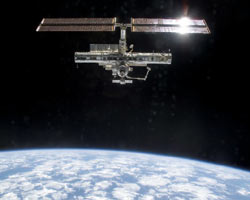 The International Space Station over Australia on December 2, 2002, as seen from shuttle Endeavour. |
During those years, the orbiting laboratory complex grew from one uninhabited module to a permanently-staffed research facility the size of a three-bedroom house.
The space station is the largest, most complex international space research project in history. Eventually, its science capacity will be tripled with components awaiting the return to flight of America's space shuttle fleet.
In the beginning... Russia's Zarya control module was the first element of the space station. It was launched from Baikonur Cosmodrome in Kazakhstan on November 20, 1998.
Two weeks later, U.S. shuttle Endeavour delivered the second element, the U.S. connecting module called Unity.
The challenges, triumphs and tragedy shared by the international partnership since then have solidified cooperation on the ISS among the United States, Russia, Europe, Japan and Canada.
Growth. The living and working areas of the station have a volume of about 15,000 cubic feet, larger than a three-bedroom house. The station continues to grow after five years. More than 80 tons of equipment and hardware are being prepared for launch on the ground at NASA's Kennedy Space Center (KSC) in Florida.
ISS has orbited the Earth more than 29,000 times. It is visible to observers on the ground looking into the night sky as it flies more than 210 miles overhead.
Habitants. The orbiting complex has been inhabited since November 2, 2000. Eight successive crews – 22 people – have staffed the space station.
Those residents have conducted research in bioastronautics, physical sciences, fundamental space biology, space product development and space flight disciplines. In the U.S. Destiny Lab alone, astronauts have worked on more than 70 different science experiments.
Ground support. Hundreds of people on Earth support ISS operations from the Mission Control Center at NASA's Johnson Space Center at Houston, Texas.
Round-the-clock science operations are handled by the Payload Operations Center team at NASA's Marshall Space Flight Center at Huntsville, Alabama.
Hundreds of other scientists and engineers perform important jobs, such as training station crews and building new hardware that will become part of the orbiting laboratory.
The future. Additional research facilities are being readied for launch when shuttle flights resume. They will enhance Destiny's capabilities in the areas of fundamental space biology; glass and porous ceramics materials processing research; human physiology research; combustion research; research on the behavior of fluids; Earth observations; and experiment refrigerator/freezer conditioned sample storage.
Also awaiting launch at KSC are solar arrays and support structures that will triple the sunlight-gathering, solar cell area, thereby increasing the power dedicated to research by 84 percent.
The Node 2 module that will serve as a connector between the U.S., European and Japanese research labs is at KSC undergoing pre-launch processing. The Kibo Japanese Experiment Module, including a pressurized lab already at KSC, will also be added to the station. The European Columbus Laboratory, under construction in Bremen, Germany, will expand the station's volume to almost that of a five-bedroom house.
Learn more:
- NASA information and images
- 1,000th day of human presence on ISS July 29, 2003
- Anniversary of human residency STO
- Space Today Online space station stories STO